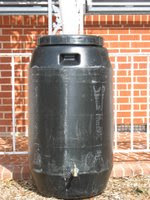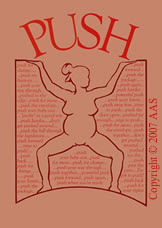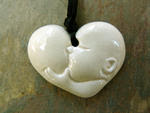--- Tricia, Child Development Professor, Homebirth mother
A poster on a blog replies to Tricia's comment:
Are you talking about NCH or home birth? Apples and oranges.
NCB in the hospital is safe. A section is available if, as you put it, you "need saving." Home birth doesn't have that.
I have to comment, though, on this: That doesn't mean we're denying that things can and do go wrong. We're just saying that we have a greater chance of surviving than dying.
Yeah... BUT.
Do you wear a seat belt?
Do you look both ways before you cross?
The risks are pretty high.
Huh? Isn't comparing seat belts (and airbags) to obstetric interventions used on all women whether necessary or not like comparing apples to oranges, dude? Or maybe it is actually more like comparing apples to brussel sprouts? Or maybe the unregulated misuse of medical technology including non-medically necessary inducation and planned surgical birth on an "in case" basis, is like expecting all Americans to be in full protective gear in case of a terrorist attack.
The seat belt analogy is very inadequate.
99.99% of the time one is safe in the car and traveling --- EVEN while it is one of the most dangerous things one can do.
Sure, when you're not safe not, you're not. But most car accidents are not life threatening and the range from scraps to fender benders to serious accidents to fatal is very broad, just like the range of degrees of danger in childbirth. It's not necessary for everyone who drives or rides in a vehicle to have rollbars and wear helmets. A seat belt is pretty efficient.
That's why we have precautions, protections, and government safety oversight and laws that car makers have to follow, as do drivers to know to drive, to be aware of the dangers, to know the precautions, and when to increase their safety measures (ie., driving in fog, snow, on freeways, gravel, etc.)
If I drive down the end of the cul de sac to pick up my kid at a friend's or go a short distance to the grocery store, do I use a seat belt? Yes, but in the end, did I really need it? Nope. YEARS of driving and accident free. Or could we liken average, everyday seatbelt wearing to good prenatal and nutritional care and preparation, training, and experience? Prenatal care improves outcomes and prevents problems --and, prenatal care does NOT case MORE damage as seat belts and airbags sometimes do, and as induction, drugs, AROM, and surgical birth do. Seat belts are mandated for "in case" and don't often, but do rarely cause death. My friend's husband died after a accident in an intersection in town. Days later he collapsed and was hospitalized because his lung had collapsed. He lingered for three months before dying -- a very healthy man just retiring. What makes obstetrics safe for a minority of women in danger actually harms far more who do not need the precautions and interventions. We would not allow the use of seatbelts if it created as many problems are interventions purported to make birth "safe."
What are the chances of being saved by the seatbelt when one actually has a wreck? Pretty good, but it also causes its own damage. Car seats can only be compared to birth if we look at the impact on the woman who is carrying the child, and how she generally, like a car, protects her passenger. It is not THE CAR that harms or kills the passenger - it is the misuse, mistakes, and accidents from other's. Very often, it is another driver who causes the accident. And, we must look at the many, many, many conditions and locations for driving cars. Am I am more aware of my need for the seat belt when I drive on I95 and I495 in NY going into the city? You betcha.
I have evolved from early days as a child NEVER wearing a seat belt (there weren't any in the back seat!) to be an adult who ALWAYS wears a seatbelt. In using the seat belt, do I hope and believe that seat belts -- and air bags -- will save my life IF I were to be in an accident? Sure. But I have driven 30-40,000 miles in one year and I never needed to be saved by the seat belt or the safety features of my Volvo. Do I feel EVEN safer in my Volvo and with the air bags? Of course. Have children been decapitated before they were banned from the front seat? Yep. Have people died in Volvos. Yep. Have a lot more people died in little inexpensive American cars? Absolutely. Do we outlaw the little cars known as "death traps?" NO. Do we insist that every car have the KNOWN safety features? NO. It's left up to INDIVIDUALS, based on their preferences and INCOME, to buy the car they want. Safety belts are the basic safety feature. Why don't we, as a society and a nation, equalize the risk and safety in car driving? Eliminate SUV's and small cars. If we really cared about saving lives we would require one kind of car for everyone -- totally equipped with every safety feature and economically available to every driver -- just like in obstetrics.
99.99% of the time one is safe in the car and traveling --- EVEN while it is one of the most dangerous things one can do.
Sure, when you're not safe not, you're not. But most car accidents are not life threatening and the range from scraps to fender benders to serious accidents to fatal is very broad, just like the range of degrees of danger in childbirth. It's not necessary for everyone who drives or rides in a vehicle to have rollbars and wear helmets. A seat belt is pretty efficient.
That's why we have precautions, protections, and government safety oversight and laws that car makers have to follow, as do drivers to know to drive, to be aware of the dangers, to know the precautions, and when to increase their safety measures (ie., driving in fog, snow, on freeways, gravel, etc.)
If I drive down the end of the cul de sac to pick up my kid at a friend's or go a short distance to the grocery store, do I use a seat belt? Yes, but in the end, did I really need it? Nope. YEARS of driving and accident free. Or could we liken average, everyday seatbelt wearing to good prenatal and nutritional care and preparation, training, and experience? Prenatal care improves outcomes and prevents problems --and, prenatal care does NOT case MORE damage as seat belts and airbags sometimes do, and as induction, drugs, AROM, and surgical birth do. Seat belts are mandated for "in case" and don't often, but do rarely cause death. My friend's husband died after a accident in an intersection in town. Days later he collapsed and was hospitalized because his lung had collapsed. He lingered for three months before dying -- a very healthy man just retiring. What makes obstetrics safe for a minority of women in danger actually harms far more who do not need the precautions and interventions. We would not allow the use of seatbelts if it created as many problems are interventions purported to make birth "safe."
What are the chances of being saved by the seatbelt when one actually has a wreck? Pretty good, but it also causes its own damage. Car seats can only be compared to birth if we look at the impact on the woman who is carrying the child, and how she generally, like a car, protects her passenger. It is not THE CAR that harms or kills the passenger - it is the misuse, mistakes, and accidents from other's. Very often, it is another driver who causes the accident. And, we must look at the many, many, many conditions and locations for driving cars. Am I am more aware of my need for the seat belt when I drive on I95 and I495 in NY going into the city? You betcha.
I have evolved from early days as a child NEVER wearing a seat belt (there weren't any in the back seat!) to be an adult who ALWAYS wears a seatbelt. In using the seat belt, do I hope and believe that seat belts -- and air bags -- will save my life IF I were to be in an accident? Sure. But I have driven 30-40,000 miles in one year and I never needed to be saved by the seat belt or the safety features of my Volvo. Do I feel EVEN safer in my Volvo and with the air bags? Of course. Have children been decapitated before they were banned from the front seat? Yep. Have people died in Volvos. Yep. Have a lot more people died in little inexpensive American cars? Absolutely. Do we outlaw the little cars known as "death traps?" NO. Do we insist that every car have the KNOWN safety features? NO. It's left up to INDIVIDUALS, based on their preferences and INCOME, to buy the car they want. Safety belts are the basic safety feature. Why don't we, as a society and a nation, equalize the risk and safety in car driving? Eliminate SUV's and small cars. If we really cared about saving lives we would require one kind of car for everyone -- totally equipped with every safety feature and economically available to every driver -- just like in obstetrics.
So, I have driven and driven year after year with my basic safety features -- whatever the government demands of the car makers at the time, and sometimes I have driven a safer than other vehicle, like my Volvo. Ironically, falling asleep with the cruise on 75 and driving off the freeway, and riding the median up on two wheels twice in the middle of Nebraska in my Toyota SUV encouraged me to buy my Volvo. My other car was a sports car and I didn't feel safe anymore. The oncoming semi during my ride made riding along side the big semi duals in my little car too terrifying. I sold 'er and got a Volvo. It was fear -- just like my first doctor-induced traumatic birth took me to the hospital three more times because I believed that birth was dangerous. Not very many people give up driving after a life-threatening or traumatic accident, but they don't easily get over it either.
(I didn't wreck that day, by the way. I stopped upright in the median and the vehicle had only a dent in the front fender where I ran over a lone little reflector when I "missed the only curve in Nebraska" as GI Joe -- who was the only one awake in the car as Baby Girl was also asleep -- then twelve recounted later. That reminds me, in the discussion about how women who birth at home risk their children's lives, do you think we women ought to EVER take our children in our cars. I mean, maybe we ought to fly -- it's statistically safer. And, truly, if our children's safety was our main consideration, we would not allow teenagers to drive alone until they are twenty. We would have four years of licensed-driver in the car. Imagine all the other things that would minimize and eliminate while enhancing parent-child relationships.)
BUT here is the key point. HOWEVER, I don't have lifelong health issues as a RESULT of wearing my seat belt, or the airbags or other features of the Volvo. My friend's husband would have lifelong health issues had he survived the seat belt. Would I be so likely to use these if I my chances for MUCH more serious consequences from using them on the remote chance I'll have an accident. No, that would be nuts. If using the safety features caused me physical damage than the actual accident, why would I do that?
This is the case with the technology and tools that make obstetric medicine "safer". They cause more damage to the baby and mother than they help -- when used unnecessarily or "in case" or for doctor and mother convenience and to minimize the DOCTOR'S RISK OF MALPRACTICE SUIT. And, in doing so, they cause the accident.
Why don't we as a society take the same precautions with c-sections? Why doesn't OB medicine have to shape up like the car makers? Why are women not expected and demanded to use the technology and drugs of obstetrics ONLY when necessary?
What if WOMEN had to pay for and carry the insurance to recover losses from pregnancy? What if the more convenience and or choosing of medically damaging NON-medically necessary interventions meant SHE paid more insurance?
You can see, I am sure, that we just can't use the simple analogy of the seat belt to compare multiple, cascading, dangerous interventions during labor and birth.
To really use the "car seat is to obstetric safety" analogy intelligently we'd have to look at adding roll bars and helmets to drive every where just in case we had an accident, or in case we might end up on the Eisenhower in Chicago during rush hour.

That's stupid.
Maybe all of us Americans should begin to wear full length camouflage gear, helmets, and bullet proof vests, hard toed boots, and carry M16's just in case we are struck by terrorists. It's just as likely to happen as birth is a a life-threatening event.
Even GI Joe gets a break from the life-saving gear and interventions and gets to rest -- even in a life-threatening situation. War.









2 comments:
That is so true. Great debunking of such a simple analogy.
If my car were like modern maternity ward, my airbag would deploy and break my neck every third time I hit the brake.
Post a Comment